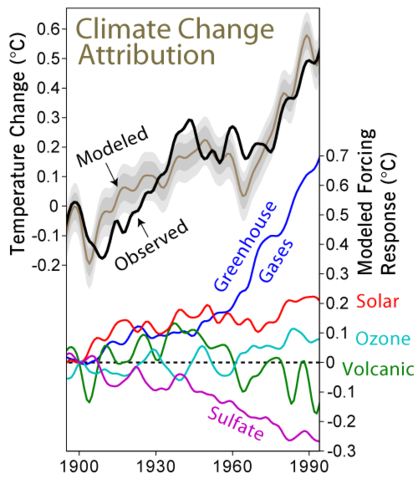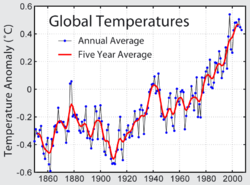Image:Climate Change Attribution.png
From Wikipedia, the free encyclopedia

Size of this preview: 418 × 479 pixels
Full resolution (500 × 573 pixels, file size: 37 KB, MIME type: image/png)
Description
This figure, based on Meehl et al. (2004), shows the ability of a global climate model (the DOE PCM ) to reconstruct the historical temperature record and the degree to which the associated temperature changes can be decomposed into various forcing factors. The top part of the figure compares a five year average of global temperature measurements (Jones and Moberg 2001) to the Meehl et al. results incorporating the effects of five predetermined forcing factors: greenhouse gases, man-made sulfate emissions, solar variability, ozone changes (both stratospheric and tropospheric), and volcanic emissions (including natural sulfates). The time history and radiative forcing qualities for each of these factors was specified in advance and was not adjusted to specifically match the temperature record.
Also shown are grey bands indicating the 68% and 95% range for natural variability in temperature relative to the climatic expectation as determined from multiple simulations with different initial conditions. In other words, they indicate the estimated size of variations that are expected to occur due to fluctuation in weather rather than changes in climate. Ideally the model should be able to reconstruct temperature variations to within about the tolerance specified by these bands. Some of the remaining misfit may be accounted for by the ~0.05 °C uncertainty in the temperature reconstruction. However, though the model captures the gross features of twentieth century climate change, it remains likely that some of the differences between model and observation still reflect the limitations of the model and/or our understanding of the histories of the observed forcing factors.
In the lower portion of the figure are the results of additional simulations in which the model was operated with only one forcing factor used at a time. A key conclusion of the Meehl et al. (2004) work is that the model response to all factors combined is to a good approximation equal to the sum of the responses to each factor taken individually. This means it is reasonable to talk about the temperature change due to individual aspects of the evolving man-made and natural influences on climate. The zeros on both plots are set equal to 1900 temperatures, and it is apparent that most of the 0.52 °C global warming between 1900 and 1994 should be attributed to a 0.69 °C temperature forcing from greenhouse gases partially offset by a 0.27 °C cooling due to man-made sulfate emissions and with other factors contributing the balance. This contrasts with the warming from 1900 to 1940 for which the model only attributes a net increases of 0.06 °C to the combined effects of greenhouse gases and sulfate emissions.
| Temperature change relative to 1900 | |||
|---|---|---|---|
| 1940 | 1970 | 1994 | |
| Greenhouse gases | 0.10 | 0.38 | 0.69 |
| Sulfate emissions | -0.04 | -0.19 | -0.27 |
| Solar forcing | 0.18 | 0.10 | 0.21 |
| Volcanic forcing | 0.11 | -0.04 | -0.14 |
| Ozone | -0.06 | 0.05 | 0.08 |
| Net | 0.19 | 0.17 | 0.53 |
| Observed | 0.26 | 0.21 | 0.52 |
Note that "Net" reflects the model runs with all factors included and is not identical to simply summing the individual factors.
References
- Meehl, G.A., W.M. Washington, C.A. Ammann, J.M. Arblaster, T.M.L. Wigleym and C. Tebaldi (2004). "Combinations of Natural and Anthropogenic Forcings in Twentieth-Century Climate". Journal of Climate 17: 3721-3727.
- Jones, P.D. and Moberg, A. (2003). "Hemispheric and large-scale surface air temperature variations: An extensive revision and an update to 2001". Journal of Climate 16: 206-223.
Licensing
This figure was created by Robert A. Rohde from published data and is incorporated into the Global Warming Art project.
| Image from Global Warming Art This image is an original work created for Global Warming Art. Permission is granted to copy, distribute and/or modify this image under either:
Please refer to the image description page on Global Warming Art for more information |
| |
This graph image was uploaded in a raster image format such as PNG, GIF, or JPEG. However, it contains information that could be stored more efficiently and/or accurately in the SVG format, as a vector graphic. If possible, please upload an SVG version of this image. After doing so, please replace all instances of the previous version throughout Wikipedia (noted under the “File links” header), tag the old version with {{ Vector version available|NewImage.svg}}, and remove this tag. For more information, see Wikipedia:Preparing images for upload. For assistance with converting to SVG, please see the Graphics Lab. |
 |
| |
This image or media file may be available on the Wikimedia Commons as Image:Climate Change Attribution.png. The uploader requests that the local copy of this work not be deleted. |
|
File history
Click on a date/time to view the file as it appeared at that time.
| Date/Time | Dimensions | User | Comment | |
|---|---|---|---|---|
| current | 01:33, 12 January 2006 | 500×573 (37 KB) | Dragons flight ( Talk | contribs) | (Modeled climate change and attributions) |
See the setup instructions for more information.
File links
The following file is a duplicate of this file:
